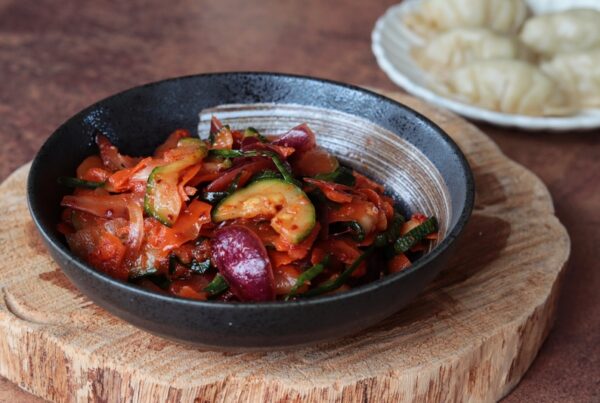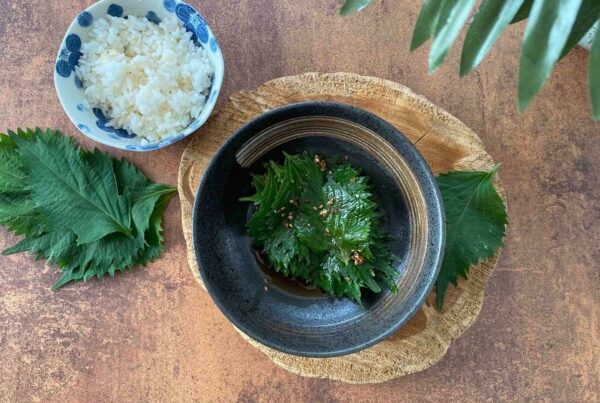
Oyakodon is known for its comforting and flavourful combination of tender chicken, fluffy eggs, and savory broth over a bed of rice. It’s a quick and easy dish, making it a popular choice for a simple and satisfying weeknight meal.
Oyakodon made its appearance in a Japanese series streamed on Netflix, “The Makanai: Cooking for the Maiko House”. The plot is about two friends who set out to Kyoto to become apprentices in the art of the geisha, steer each of them toward separate paths.
What is Oyakodon?
Oyakodon is a popular Japanese dish that consists of chicken, onions, and eggs simmered in a savoury, slightly sweet sauce and poured over freshly cooked rice.
Oyakodon is a type of ‘donburi,’ which means ‘rice bowl’ in Japanese. Donburi dishes are staples in Japanese cuisine and are considered quick comfort meals. They are also popular choices during lunch hours as they represent a simple yet delicious one-bowl meal. Paired with miso soup and some vegetable side dishes, you have a delicious and tasty lunch set.
If you replace chicken with beef, you’ll get Tanindon. This name can be considered a wordplay. Tanin means stranger or unrelated person in Japanese, so the name indicates that beef and eggs are not related. Then there are another rice bowl dishes like Gyudon (beef rice bowl) or Katsudon (pork cutlet rice bowl). Donburi dishes are such a flexible meals. You can put pretty much anything over the rice and call it “don”.
Ingredients for Making Oyakodon
- Chicken meat – You can use either chicken thighs or breasts. Many people prefer thighs over breasts because they are fattier and juicier, adding more flavour.
- Onion – use yellow or white onion. I do not recommend using shallots or red onions.
- Dashi – do not omit dashi (Japanese soup stock), it adds the rich umami flavour. I used dashi powder as it’s the easiest option for me.
- Eggs – I recommend they be at room temperature. Usually, one and a half or two eggs go into one portion. I used three eggs for two portions.
- Something green – mitsuba is an herb used in many donburi dishes. It’s a Japanese wild parsley but it may be hard to get outside of Japan so I substituted with thinly sliced spring onion, or you can also use shredded nori seaweed.
How to Make Oyakodon?
Oyakodon is considered a quick one-bowl, one-pan meal that can be made in 30 minutes. However, if you ever tried (or will try) oyakodon in restaurants, you may notice slight differences. Here’s why including some cooking tips.
Tips on Making Oyakodon
1. The size of the pan matters
Use small to medium-sized pan and try to make one or two portions in one pan. Why? If you cook a bigger batch in a large pan, it will take longer to cook, the seasoning will not evaporate efficiently, and you may end up with too much sauce. And there is also an aesthetic aspect. It will be difficult to divide such a large batch into bowls. In Japan, they even have a special pan for this dish. Its size is tailored for just one serving and it looks almost like a larger ladle, from which they simply scoop the finished oyakodon onto rice, thus preserving its shape.

2. Mastering cooking the eggs
In a restaurant, you’ll probably get oyakodon with perfectly cooked eggs. They should be firm yet slightly wobbly, and the egg yolk should be soft, a bit runny, and distributed evenly, creating a nice colour scheme. The secret lies in using the right size of the pan and timing. First, let the eggs come to room temperature; it will help cook them faster. Egg whites need more time to cook than egg yolks, so you have three options:
- Adding eggs at two separate times: Crack the eggs, poke the egg yolks a bit, and mix gently so it looks like marble. Add a portion of eggs (ideally more egg whites) in the center and cook for a bit. Then add the rest.
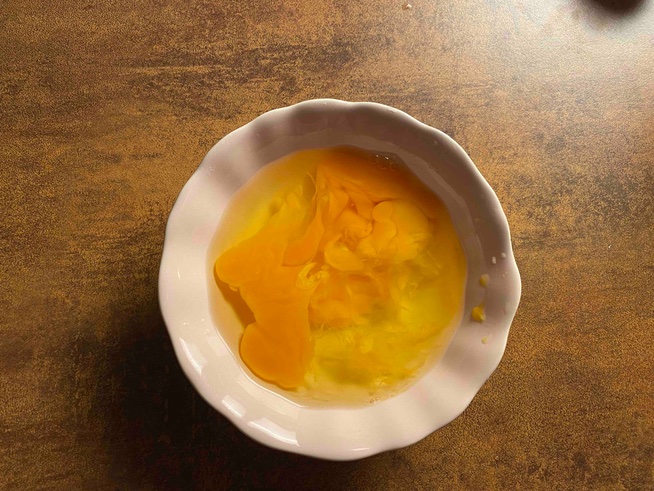
- Preparing egg whites and egg yolks separately: Separate egg yolks and egg whites into two bowls so you can manage the amount you add better.
- Putting all at once: If you feel this is too much of a hassle or if you don’t like half-cooked eggs, just add the entire mixture at once and cover with a lid to cook the eggs properly. After all, this should be a quick and easy-to-make meal.
3. Slice the chicken into equal pieces
When cutting the chicken, aim for bite-sized pieces, approximately 2 cm. Pieces like these will absorb the sauce flavour better and will better incorporate into the eggs.
Interested to discover more about Japanese cooking? Let’s keep in touch on Instagram, Facebook, and Pinterest.
Sharing is caring:
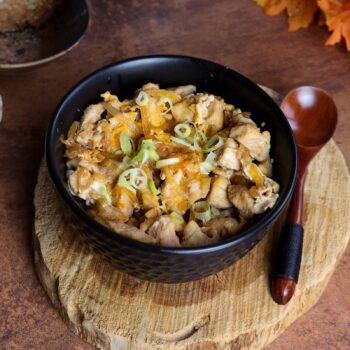
Oyakodon (Chicken and Egg Rice Bowl)
Video
Ingredients
- 1 chicken breast (approx. 280 g) or chicken thighs
- 1 onion (approx. 80 g)
- 3 eggs
- Salt
Seasoning:
- 120 ml water
- 1 tsp dashi powder
- 2 tbsp soy sauce
- 2 tbsp mirin
- 2 tsp sugar
Instructions
- First, prepare the seasoning. Mix all the ingredients and set aside.
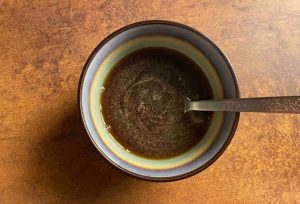
- Cut the onion. It shouldn't be thinly sliced. About 5 mm wide is okay.
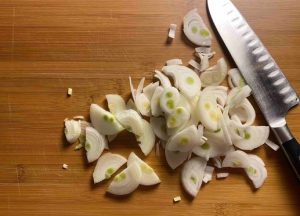
- Slice the chicken into equally sized pieces (about 2 cm) and sprinkle with salt.
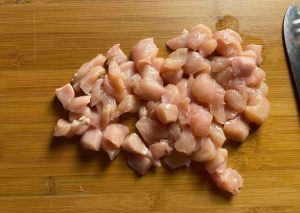
- Crack the eggs into a bowl. Using chopsticks or fork poke them gently to create a marble effect.
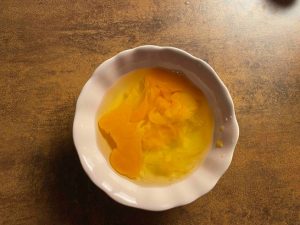
- I made one portion at a time, so I divided all ingredients in half. Put the sauce and onion in the pan and turn on the heat. Once it starts simmering, add the chicken. Let it cook. Occasionally stir gently and flip the chicken. You don't need to cover the pan with a lid.
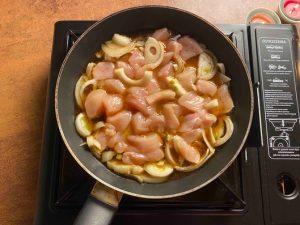
- I added the eggs two times. You can increase the heat to medium. Tried to add more egg whites first as they need more time to cook with little bit of egg yolks. Let it cook a bit. You don't have to use the lid. But you can, if you want to cook it faster.
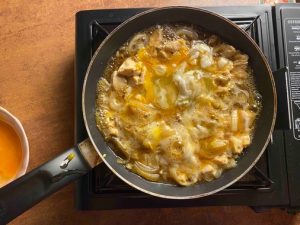
- Add the rest of the eggs and cook until desired texture.
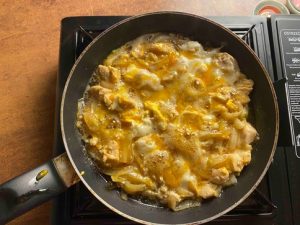
- Typically, the eggs should be wobbly and the egg yolks should be a little bit runny but I would say it's up to you. I cooked it slightly more than I should have because some members of our family don't like half-cooked eggs.
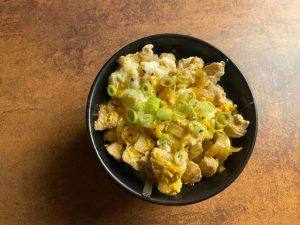
Itadakimas!

